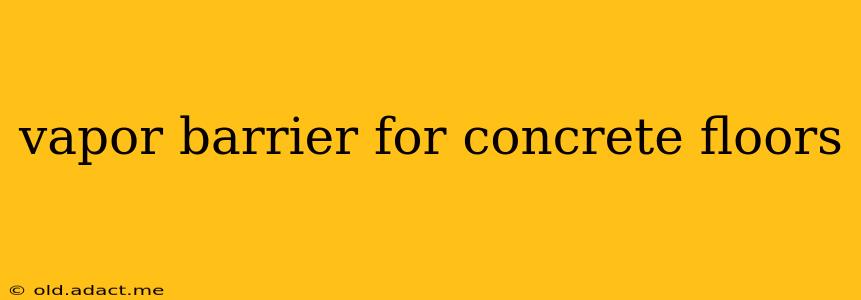Concrete floors, while durable and versatile, can present a challenge when it comes to moisture management. Understanding the role and selection of a vapor barrier is crucial for preventing moisture-related problems like mold, mildew, and damage to flooring materials. This comprehensive guide will explore the essential aspects of vapor barriers for concrete floors, answering common questions and providing expert advice.
What is a Vapor Barrier for a Concrete Floor?
A vapor barrier is a material designed to impede the passage of water vapor. In the context of concrete floors, it's a layer installed beneath the flooring to prevent moisture migrating from the concrete slab into the finished floor. This is especially important in basements, crawl spaces, and areas with high humidity or ground water levels. The barrier prevents damage to the flooring itself (like warping or buckling of wood) and protects the building from mold and mildew growth, preserving its structural integrity and occupant health.
What are the Different Types of Vapor Barriers?
Several materials serve effectively as vapor barriers for concrete floors, each with its pros and cons:
-
Polyethylene Sheeting: This is a common and cost-effective option. It's readily available, easy to install, and offers good vapor resistance. However, it can be susceptible to punctures and tears during installation.
-
Polyurethane Sheets or Coatings: Polyurethane offers superior strength and resistance to punctures, providing a more durable solution. Coatings can be applied directly to the concrete, offering a seamless barrier.
-
Asphalt-Based Emulsions: These are effective sealants that penetrate the concrete's surface, reducing permeability. They are often used as a primer or in conjunction with other vapor barriers.
-
Vapor Retarding Paints: These specialized paints offer a relatively thin barrier. While not as effective as a dedicated sheet barrier, they can still provide some protection in less humid environments.
How Do I Choose the Right Vapor Barrier?
The best vapor barrier for your concrete floor depends on several factors:
-
Climate: In humid climates, a high-performance barrier like polyurethane is preferable. In drier climates, a polyethylene sheet might suffice.
-
Existing Moisture Levels: If you have high existing moisture levels, you may need a more robust barrier and potentially moisture mitigation measures before installing any barrier.
-
Budget: Polyethylene is the most economical choice, while polyurethane and other specialized options are more expensive.
-
Type of Flooring: Different flooring materials have different moisture sensitivities. Engineered wood, for instance, is more susceptible to moisture damage than ceramic tile. The flooring choice will directly influence the choice of vapor barrier.
-
Installation Method: Sheet barriers are easier for DIY projects, while polyurethane coatings require professional application.
Do I Need a Vapor Barrier Under Concrete?
While you don't always need a vapor barrier under the concrete slab itself (the concrete can act as some form of barrier), installing one beneath the concrete is highly recommended in many situations. This is especially true in basements or areas prone to high moisture. It significantly reduces the chance of moisture problems affecting the floor above.
How Much Does a Vapor Barrier Cost?
The cost varies considerably depending on the type of vapor barrier and the size of the area. Polyethylene sheeting is generally the most affordable, while professional installation of polyurethane coatings can be significantly more expensive.
How is a Vapor Barrier Installed?
Installation methods vary depending on the chosen material. Polyethylene sheets are typically rolled out and overlapped, sealed with tape. Polyurethane coatings are applied using specialized equipment by professionals. Always follow manufacturer instructions carefully for optimal performance.
Can I Install a Vapor Barrier Myself?
Installing a polyethylene vapor barrier is a relatively straightforward DIY project. However, polyurethane coatings and other more complex systems usually require professional installation.
What Happens If I Don't Use a Vapor Barrier?
Failure to use a vapor barrier in high-moisture areas can lead to several problems, including:
-
Mold and mildew growth: This can cause health issues and structural damage.
-
Warped or damaged flooring: This is especially true for wood flooring.
-
Musty odors: Moisture trapped in the concrete can create unpleasant smells.
-
Reduced lifespan of the floor: Moisture will damage your flooring over time.
Choosing and installing the appropriate vapor barrier is crucial for maintaining a healthy and comfortable living environment. By considering these factors and seeking professional advice when needed, you can ensure the longevity and performance of your concrete floor and protect your investment.
